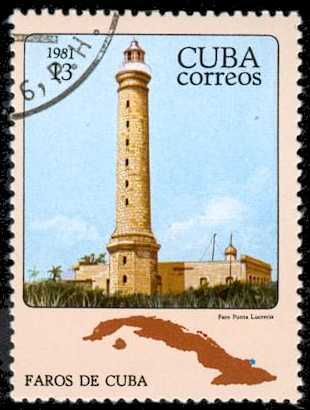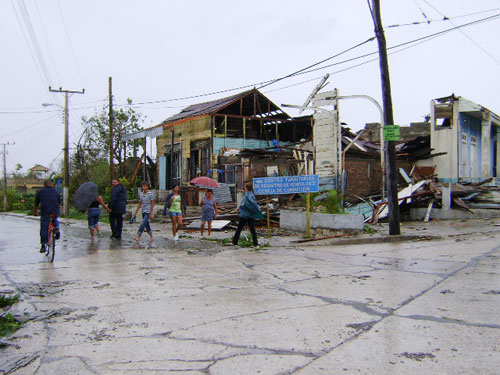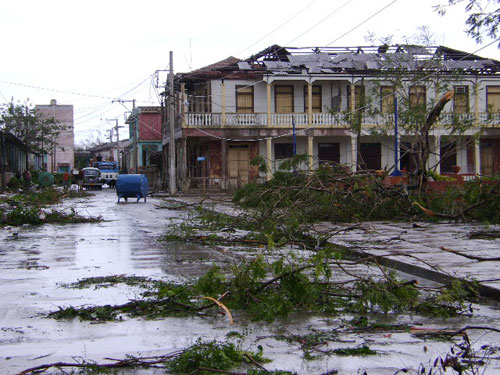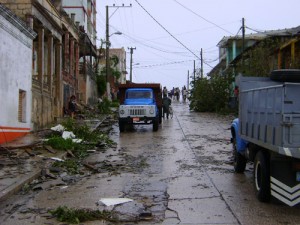Meeting a Hurricane Face to Face
By DALIA ACOSTA

HAVANA TIMES, Dec. 21 (IPS).- Coffee was ready, documents and files had been removed to a safe place, communications equipment was switched off and the optical system was secured. With nothing left to do but wait, Cuban lighthouse keeper Miguel Chacon climbed the 218 stairs to the tower of the Cape Lucrecia lighthouse and looked out to sea.
“When it was getting dark, I saw a black cloud on the horizon and thought ‘how low it is.’ But then I realized and said: ‘good heavens, that’s the sea!’ And it crashed into the coast,” said the 63-year-old Chacon, who had the unique privilege — if that is the right word — to see hurricane Ike making landfall in eastern Cuba on Sept. 7.
“The lighthouse felt like a bottle in the water. It must have been about nine o’clock at night when the sea surged in and started smashing the windows. The lighthouse was booming like a drum. I thought the tower would break in two with me inside it,” Chacon, who had decided not to evacuate, told reporters from the Cuban newspaper Ahora and IPS.
Built in 1868 to guide shipping along a low-lying coastline surrounded by coral reefs, and declared a local monument in 1995, the Cape Lucrecia lighthouse stood firm against the fury of the sea and the winds of more than 195 kilometers per hour that were unleashed on this part of the Caribbean island nation.

Ike was the second of three high-intensity hurricanes to devastate Cuba in this year’s hurricane season. In their wake they left an absolutely flattened landscape, damages estimated at some 10 billion dollars, and over two million people with destroyed or damaged homes.
“The worst came after the eye of the hurricane. The wind was unbearable. I could also hear stones thrown up by the sea crashing against the tower with increasing force. It was as if the world was coming to an end or the tower was falling, which was pretty much the same thing. I said to myself ‘God’s will be done’ and fell asleep at the window,” Chacon said.
———————–
A transformed landscape

“The trees were left completely leafless. Everything looked red (from the color of the soil). I had never seen anything like it in my entire life,” said 48-year-old Mariela Bermudez, who mentioned the 261 kilometers per hour gusts of wind recorded on radar above the city of Banes, in the eastern Cuban province of Holguín.
Although the landscape has begun to turn green again, Ike’s footprints can be seen all along the road to Banes, which climbs over a mountain range. Destroyed houses alternate with entire cemeteries of royal palm trees (Roystonea regia), a species protected in Cuba for its landscape value and as a nesting site for birds.
More than 133,000 royal palms, known as the “queen of the countryside”, were damaged by the hurricane in Holguín alone, according to a preliminary environmental impact study carried out in September by experts from the Ministry of Science, Technology and the Environment (CITMA).
The Alexander von Humboldt National Park, shared by the provinces of Holguín and Guantánamo, displays the impact of Ike on some 5,000 hectares of forest ecosystems and human settlements. And in the Pico Cristal National Park, also in Holguín, 2,900 hectares were affected by the natural disaster.
The coastal ecosystem was one of the hardest hit as the sea penetrated up to a kilometer and a half in some zones. The storm surge damaged several kilometers of different coral species which typically form coral reefs and dissipate wave energy.
The sea’s fury wiped the coast clean of almost all vegetation. Coastal scrublands were severely affected, endemic species have been lost and the ecological niches of the cave shrimp (Barbouria cubensis) were damaged, as well as estuaries and thousands of hectares of natural and planted forests. Much fertile topsoil was also lost.

The passage of Ike marked every tree and field in the short distance between Banes and Cape Lucrecia, and every house in Cuba’s archaeological capital, so called because of the discoveries made on the ancient site of Bani, the most developed community on the island at the time of the arrival of the Spanish conquistadors.
“We never paid much attention to the hurricane warning. But now we spend all our time thinking about the need to change our building plans. We have to build safer houses, because it’s easy to rebuild a house, but whatever was inside it cannot be recovered,” Orlando Velázquez, deputy mayor of Banes, told IPS.
Seven out of 10 homes suffered some degree of damage in this municipality of 80,600 people. Official statistics indicate that Ike demolished 4,045 houses and tore the roof off of a further 3,656. Most houses in the area were built in the traditional manner using wood and light roof covering, and they did not withstand the storm.
More than 5,000 dwellings, particularly those with only partial damage to the roof, have been made habitable with help from the municipality and the state, and work is in progress to replace the over 4,000 demolished houses with new ones made of masonry and concrete roofs, or to ensure that at least one room in each house is built of these stronger materials.
“I can’t imagine what it must have been like at Cape Lucrecia,” Bermudez remarked. Three months after hurricane Ike, she still can’t sleep when it starts to rain. “I just think about my mother,” she said. “The hurricane knocked her roof tiles around, but she says she will die in her own home. Any heavy rain or the first little wind could put her in danger.”
At ground level

With a height of not much more than a meter, like a gable roof placed on the ground, the low sheds used for storing tools and harvested crops were the real survivors of the hurricanes that lashed Cuba this year. In some cases they provided safe shelters for people, as well.
“Cyclones don’t sweep too close to the ground,” island country folk say, and there appears to be some truth in this. These low sheds can offer a secure refuge, so long as the rain is not too intense, in areas far away from the coast or rivers and reservoirs that are not susceptible to flooding.
But they would never be a solution in Cape Lucrecia, where the sea dug up fragments of ceramic tiles, pottery, oil jars and other vessels and bricks, among a wide range of archaeological material dating from the colonial period, probably linked to the different stages of construction of the lighthouse and the keeper’s house.
At dawn on Sept. 8, Miguel Chacon came down from the lighthouse tower and went to his house. The door and practically everything inside was gone. Mattresses were tangled in trees and bushes, and his food stores were destroyed. Two days later, when he decided to visit his family, he had to cut his way through with an axe and a machete.
On the way to his daughter’s house, Chacon overheard the story that was being told about him. Kilometers away from Banes, the word was that a man had gone crazy because he had decided to stay all alone in the Cape Lucrecia lighthouse, and at the moment Ike made landfall he had seen a great ball of fire coming towards him.
“The thing is, people talk a lot and they like to invent. I didn’t see a ball of fire and I didn’t run out screaming. I only repeated two things all night long: good heavens and God’s will be done. The tale that I ran out screaming is all lies,” said the first Cuban to have met with Ike.
